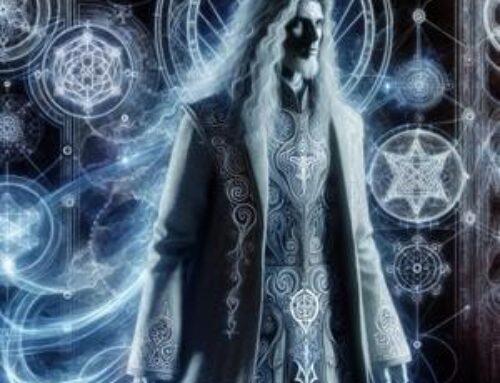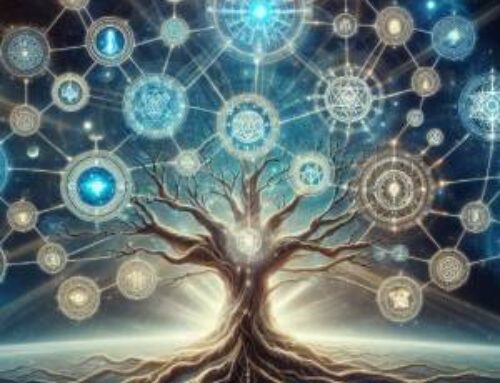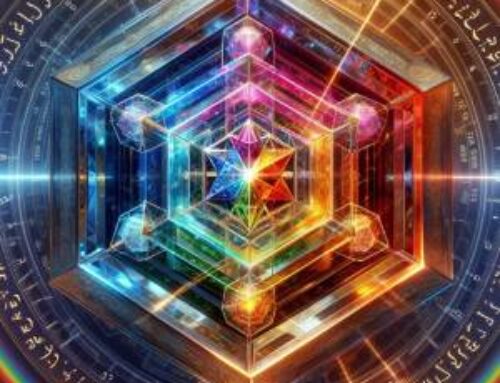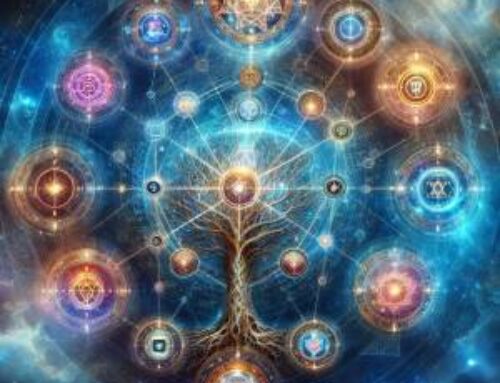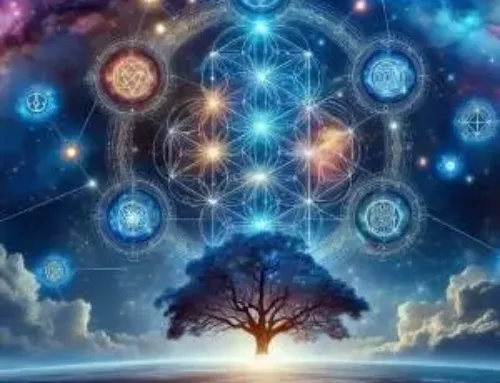Contents
- 1 Introduction to Eastern Mysticism and Kabbalah
- 2 Unveiling the Unity of Eastern Mysticism and Kabbalah
- 3 The Teachings and Rites that Bind Eastern Mysticism to Kabbalah
- 4 The Role of the Tree of Life in Spiritual Growth
- 5 Ancient Wisdom in the Modern Vortex
- 6 The Contested Waters of Mystical Traditions
- 7 Charting Your Course Through Eastern Mysticism and Kabbalah
- 8 Conclusion
- 9 FAQ – Eastern Mysticism and Kabbalah
- 9.1 1. In what manner do Eastern Mysticism and Kabbalah unite to foster spiritual advancement?
- 9.2 2. Is it possible to meld the discoveries of modern science with the ancient wisdom of Eastern Mysticism and Kabbalah?
- 9.3 3. Upon what avenues should one embark to explore the realms of Eastern Mysticism and Kabbalah?
- 9.4 4. What misconceptions cloud the understanding of Eastern Mysticism and Kabbalah, necessitating enlightenment?
- 10 References
Introduction to Eastern Mysticism and Kabbalah
In the boundless reaches of the cosmos, where the luminescence of sagacity casts light upon the shadowed mysteries of the uncharted, there exists a profound amalgamation of spiritual wisdom and comprehension—a nexus of Eastern Mysticism and Kabbalah. This fusion, steeped in antiquity and profundity, extends to seekers a route adorned with complex teachings and mystical rites that have shepherded spirits through millennia. In this inquiry, we journey into the core of these venerable traditions, deciphering the intricate weaves of spiritual edicts and celestial truths that summon the contemporary seeker to the paramount pursuit of illumination.
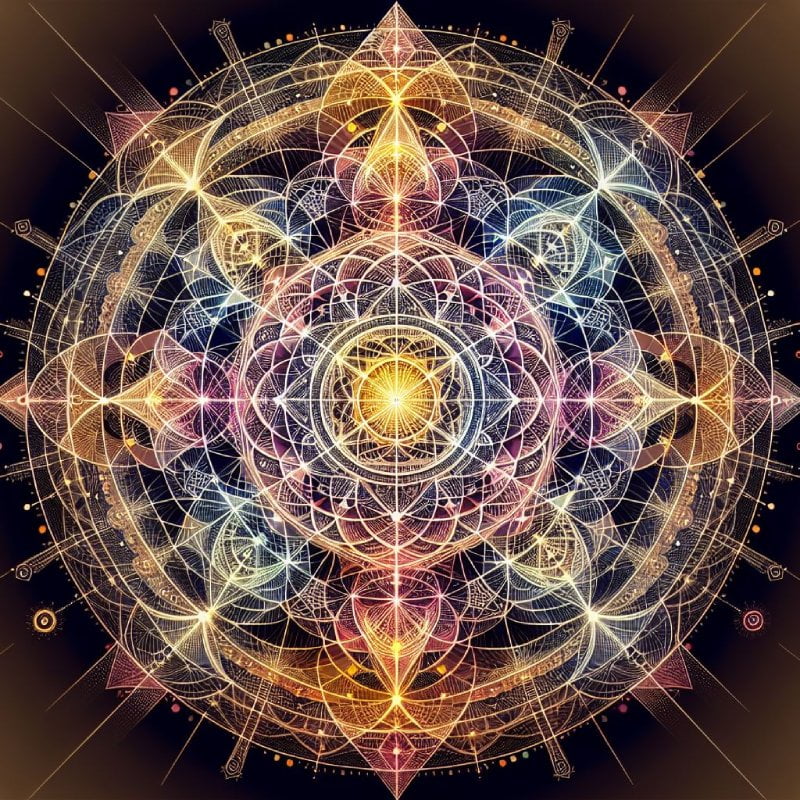
From the hallowed scriptures of the East to the enigmatic Kabbalistic Tree of Life, we discern shared filaments intertwining within the loom of spiritual praxis, each offering distinct revelations about the essence of being, the cosmic unfoldment, and the soul’s pilgrimage towards its celestial source (1). As we navigate the domains of Eastern Mysticism and Kabbalah, we unearth not just the philosophic or theologic musings but a vital, animate compass for the metamorphosis of the self and the acknowledgement of the unity of all existence.
Unveiling the Unity of Eastern Mysticism and Kabbalah
In the realm where ancient wisdom crosses paths, Eastern Mysticism and Kabbalah reveal a shared landscape of spiritual insight and enlightenment. This harmonious crossing is not just a subject of intellectual fascination but a luminous guide for those seeking the universal truths nestled within all mystical endeavors.
Echoes of Ancient Wisdom
The roots of Eastern Mysticism and Kabbalah stretch deep into the annals of spiritual history, each charting a course through time that reflects a quest for understanding beyond the material. As we examine the genesis and evolution of these traditions, we discover a mirrored reflection of profound truths and insights, despite the varied cultures and epochs from which they emerge.
The Essence of Reality Through Varied Lenses
Delving into the foundational teachings of both paths, we uncover their methods for deciphering the cosmos’s intricacies, the divine’s nature, and the individual’s quest for transcendence. Although articulated through distinct symbols and texts, the core principles resonate with a shared conviction in the interconnectedness of all existence and the possibility of attaining a higher state of consciousness (2).
The Teachings and Rites that Bind Eastern Mysticism to Kabbalah
Within the sanctum of mystical study, where the seeker treads upon the hallowed ground of self-discovery, lies the essence of Eastern Mysticism and Kabbalah. These spiritual disciplines, though geographically and culturally distinct, share a foundational commitment to the unraveling of existential mysteries through rigorous practice and devoted study.
The Path to Inner Alchemy
At the heart of these traditions lies the transformative journey of the self. This journey is a lifelong process (3). Eastern Mysticism, with its rich tapestry of meditation, yoga, and contemplation, offers a roadmap to inner peace and enlightenment. Similarly, Kabbalah employs meditation, the study of sacred texts, and the practice of rituals as vehicles for spiritual ascent. Both paths advocate for an inner alchemy, where the mundane becomes sacred, and the seeker is reborn into a higher state of awareness.
Wisdom Encoded in Sacred Symbols
Both Eastern Mysticism and Kabbalah communicate profound spiritual truths through symbols and allegories. The Kabbalistic Tree of Life, with its sephirot and paths, mirrors the Eastern chakra system in its representation of cosmic and psychological forces. These symbols serve as maps for the spiritual aspirant, guiding them through the complexities of the self and the universe.
A Practice of Presence and Awareness
The quintessence of both traditions is the cultivation of a heightened state of presence and awareness. Through practices such as mindfulness, meditation, and the recitation of mantras or prayers, the individual learns to dwell in the eternal now. This awareness brings about a profound connection to the divine, the self, and the entirety of creation, revealing the unity that underlies apparent diversity.
The Role of the Tree of Life in Spiritual Growth
Within the mystical landscapes of Eastern Mysticism and Kabbalah, the symbol of the Tree of Life stands as a monumental pillar, bridging the finite with the infinite, the earthly with the divine. This emblem, though arising from the rich soil of Kabbalistic teachings, finds its echo in the spiritual traditions of the East, where trees often symbolize life, growth, and spiritual awakening.
The Lattice of Cosmic Connection
The Tree of Life is not merely a symbol but a vibrant, living structure that maps out the universe’s architecture and the soul’s progression through it. With its roots anchored in the divine source and its branches reaching out to the myriad aspects of creation, it mirrors the Eastern concept of Indra’s Net, where every individual gem reflects all others in a boundless, interconnected web.
Guidance for the Ascent
Each sephira (Hebrew: SPhYRH), sphere, on the Tree of Life encapsulates a divine attribute or emanation, offering the seeker waypoints on their ascent towards enlightenment. This journey through the sephirot (Hebrew: SPhYRVTh) is akin to the Eastern practice of ascending through the chakras, where each energy center represents a stage of spiritual awakening and personal development.
Mystical Practices for Nurturing Growth
The contemplation and meditation on the Tree of Life serve as profound practices for nurturing spiritual growth. Through visualization, prayer, and the embodiment of the sephirot’s virtues, one cultivates a holistic understanding of their place within the cosmos. Similarly, Eastern practices that focus on aligning and balancing the chakras encourage a harmonious flow of energy that supports one’s spiritual maturation.
Ancient Wisdom in the Modern Vortex
In today’s whirlwind of technological advancement and rapid change, the perennial wisdom of Eastern Mysticism and Kabbalah offers a grounding force, a compass by which we navigate the complexities of contemporary life. These ancient teachings, though rooted in times and cultures far removed from our own, hold keys to addressing the existential dilemmas and spiritual hunger that pervade modern society.
Integrating the Eternal with the Everyday
The principles of mindfulness and presence, central to both Eastern and Kabbalistic practices, find a ready application in combating the modern malaise of distraction and disconnection. By adopting practices such as meditation, contemplative study, and intentional living, individuals rediscover a sense of wholeness and purpose amid the chaos of daily life.
Harnessing Technology for Spiritual Growth
In an age where technology often seems at odds with spiritual pursuits, the teachings of Eastern Mysticism and Kabbalah provide a framework for using these tools in service of personal development and enlightenment. From online meditation communities to apps that guide users through Kabbalistic studies, technology becomes a means of spreading ancient wisdom and fostering a global spiritual community.
Addressing Modern Challenges Through Ancient Insights
The ethical and moral teachings embedded in Eastern and Kabbalistic traditions offer timeless guidance on contemporary issues such as environmental stewardship, social justice, and personal integrity. By applying these teachings to current challenges, we find paths towards creating a more harmonious and sustainable world.
The Contested Waters of Mystical Traditions
As we delve into the depths of Eastern Mysticism and Kabbalah, we encounter not only the profound and transformative wisdom these traditions offer but also the turbulent waters of challenges and controversies that swirl around their practice and interpretation in the modern era. These ancient paths, rich with spiritual insights, also navigate the complexities of appropriation, misinterpretation, and the quest for authenticity.
The Quest for Authenticity in an Age of Information
In a time where spiritual teachings are readily accessible, discerning the authentic from the superficial becomes a crucial challenge. The widespread availability of mystical texts and practices online has led to a dilution and sometimes misrepresentation of these deep teachings, prompting a renewed emphasis on traditional study and the guidance of genuine teachers.
Cultural Appropriation and the Integrity of Spiritual Practices
The global interest in Eastern Mysticism and Kabbalah raises important questions about cultural appropriation and respect for the origins and contexts of these spiritual paths. Balancing reverence for these traditions while making them accessible to a diverse, global audience is a nuanced endeavor that requires sensitivity and awareness.
Modern Skepticism and the Mystical Experience
In a world increasingly oriented towards the empirical and the tangible, mystical experiences and the metaphysical aspects of Eastern Mysticism and Kabbalah often face skepticism and dismissal. This clash between differing worldviews invites a dialogue on the nature of reality and the validity of subjective spiritual experiences.
Ethical Dilemmas and Spiritual Authority
As with any area of profound human interest, the realms of Eastern Mysticism and Kabbalah are not immune to the challenges of ethical integrity and the misuse of spiritual authority. Navigating these ethical dilemmas and ensuring that spiritual leadership is exercised with integrity and compassion remains an ongoing concern.
Charting Your Course Through Eastern Mysticism and Kabbalah
Embarking on the spiritual voyage that Eastern Mysticism and Kabbalah present is akin to setting sail on vast, uncharted waters. With the stars of ancient wisdom to guide and the compass of personal intuition in hand, seekers navigate through the profound depths and exhilarating heights of spiritual exploration. This journey, rich with discovery, also demands keen discernment, steadfast commitment, and an open heart as travelers chart their unique courses toward enlightenment.
The Importance of Guidance and Community
In the vast expanse of spiritual teachings, the guidance of seasoned navigators—teachers who have traversed these paths themselves—becomes invaluable. Likewise, joining a community of fellow seekers offers not only companionship but a shared repository of experiences and insights that can illuminate the way forward.
The Map of Texts and Traditions
The sacred texts and oral teachings of Eastern Mysticism and Kabbalah serve as maps, offering routes through the complexities of spiritual growth and inner transformation. Engaging deeply with these teachings, through both study and practice, allows seekers to uncover the layered meanings and apply them to the personal quest for divine connection.
The journey through Eastern Mysticism and Kabbalah is ultimately an inward one, navigating the terrains of the mind, heart, and spirit. Practices such as meditation, prayer, and ethical living act as tools for this internal exploration, helping to quiet the ego, awaken the higher self, and cultivate a direct experience of the divine. Techniques of Meditation aim to reduce mental activity while maintaining full consciousness (4).
Overcoming Challenges and Obstacles
Along the spiritual path, seekers inevitably encounter storms—doubts, fears, and the challenges of integrating spiritual insights into daily life. Facing these obstacles with perseverance and faith strengthens the resolve and deepens the commitment to the journey.
Charting Your Course
While the teachings of Eastern Mysticism and Kabbalah provide a rich framework for exploration, each seeker’s journey is uniquely their own. Embracing the personal quest for truth requires an openness to where the path may lead, guided by the inner light of one’s own spirit and the universal truths that these ancient wisdoms illuminate.
Conclusion
As our examination of the entwined routes of Eastern Mysticism and Kabbalah draws to its climax, we stand before a moment of deep significance. This odyssey, crossing the wisdom of eons and diverse cultures, shines a light not only upon the expanse of the external realm but also deep within the recesses of our own essence. It’s a quest that beckons us to untangle the enigmas of our being and to forge a direct, profound bond with the boundless.
The doctrines of Eastern Mysticism and Kabbalah, brimming with ancient lore and transformative rites, act as luminaries on our quest for enlightenment, steering us toward an awakening to our authentic nature and our position in the vast cosmos. This spiritual expedition, arduous yet immensely fulfilling, calls upon us to transcend the ordinary, to cast aside the veils of delusion, and to step into the radiance of consciousness and oneness.
Connect with a Lineage of Spiritual Wisdom
Whether you are setting foot upon the threshold for the initial time or aiming to enrich your current practices, the Hermetic Academy provides a treasure trove of resources, teachings, and opportunities for communion to enhance your delve into these venerable wisdom traditions. Together, we are equipped to traverse the intricacies of the contemporary realm, fortified with the transformative insights and spiritual disciplines that have cast light upon the paths of myriad explorers through the epochs.
FAQ – Eastern Mysticism and Kabbalah
1. In what manner do Eastern Mysticism and Kabbalah unite to foster spiritual advancement?
A: Within the sacred tapestries of Eastern Mysticism and Kabbalah, there lies a shared pursuit of the soul’s alchemy, the unveiling of the cosmos’ veiled truths, and the quest for knowledge attained not through scholastic study but through the soul’s journey. Eastern Mysticism offers the seeker the tools of meditation and yoga as keys to unlocking the inner sanctum, while Kabbalah maps the celestial ascent through the Tree of Life, charting pathways threaded with ancient mysticism.
2. Is it possible to meld the discoveries of modern science with the ancient wisdom of Eastern Mysticism and Kabbalah?
A: Verily, the tapestry of the cosmos, as woven by the threads of Eastern Mysticism and Kabbalah, finds its patterns echoed in the fabric of contemporary science. The doctrines preaching the symphony of all existence and the subtle dance of energies find kinship with the laws governing the physical universe, illustrating a grand concord between the mystic and the empirical, bridging aeons of wisdom with the pinnacle of modern human inquiry.
3. Upon what avenues should one embark to explore the realms of Eastern Mysticism and Kabbalah?
A: Seekers at the threshold are beckoned to immerse themselves in the foundational scrolls and to forge connections with gatherings or academies, such as the venerable Hermetic Academy. Herein lies a wellspring of knowledge, a community of fellow navigators of the spiritual expanse, offering lanterns to light the way along these ancient pathways now tread anew.
4. What misconceptions cloud the understanding of Eastern Mysticism and Kabbalah, necessitating enlightenment?
A: A veil of misapprehension oft shrouds these sacred teachings, suggesting they are sanctuaries for only the elect or demand withdrawal from the worldly stage. Yet, both Eastern Mysticism and Kabbalah proclaim with unwavering voice that the divine enlightenment and the blossoming of the spirit are the birthright of all souls, and that within the tapestry of daily existence, the threads of the sacred are intricately woven, awaiting revelation to the earnest seeker.
References
(1) Rubenstein, E. (2020). The Tree of Life: The Kabbalah of Immortality. Hermetic World, Paphos.
(2) Fasching, W. (2008). Consciousness, self-consciousness, and meditation. Phenomenology and the Cognitive Sciences, 7, 463-483. https://doi.org/10.1007/S11097-008-9090-6.
(3) Keegan, L. (1991). Spiritual Journeying. Journal of Holistic Nursing, 9, 14 – 3. https://doi.org/10.1177/089801019100900103.
(4) Fasching, W. (2008). Consciousness, self-consciousness, and meditation. Phenomenology and the Cognitive Sciences, 7, 463-483. https://doi.org/10.1007/S11097-008-9090-6.

